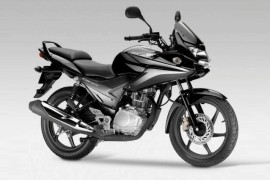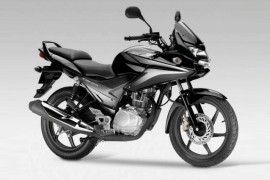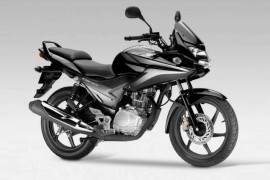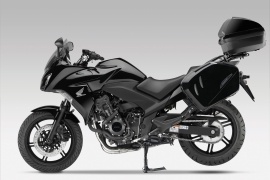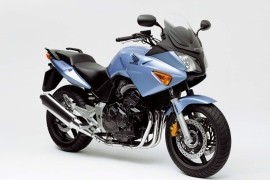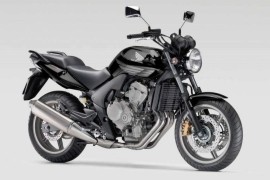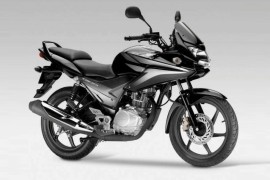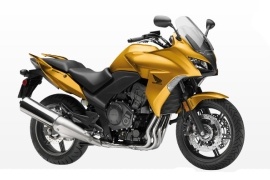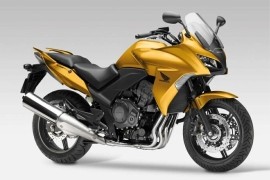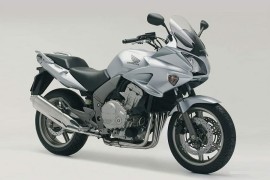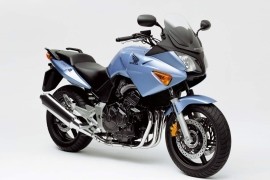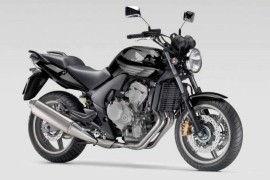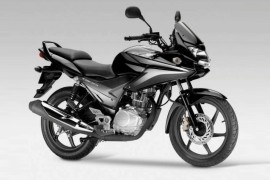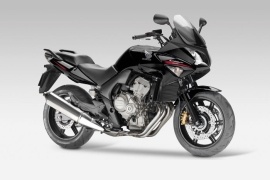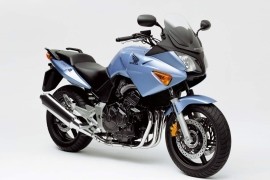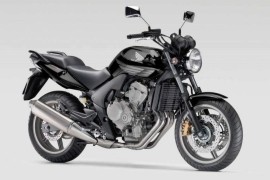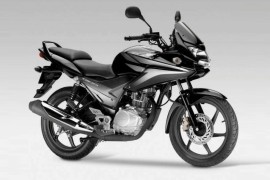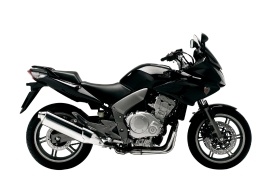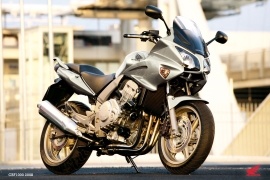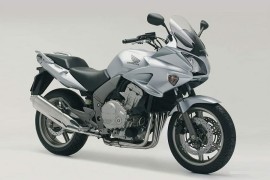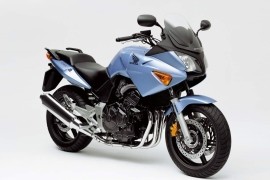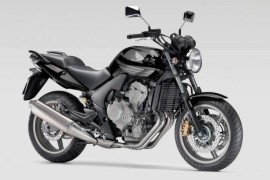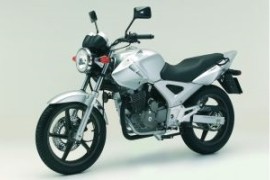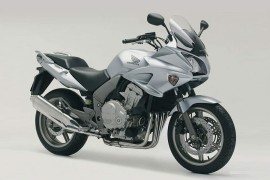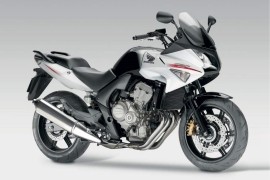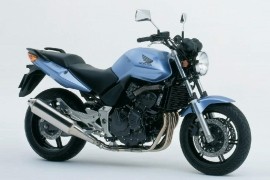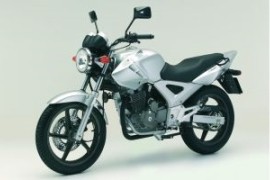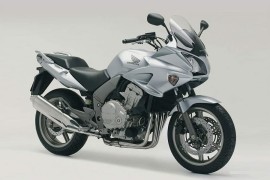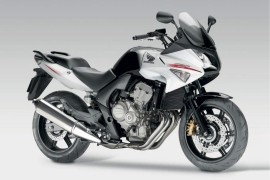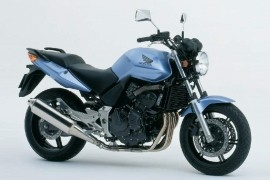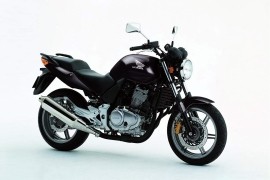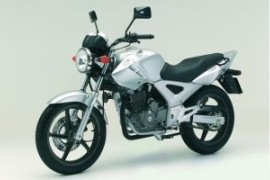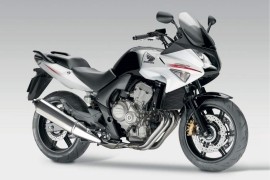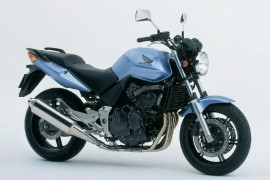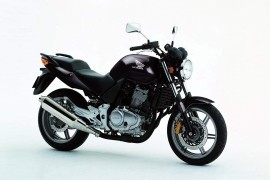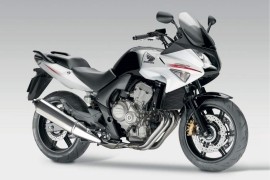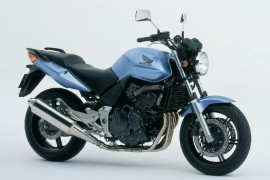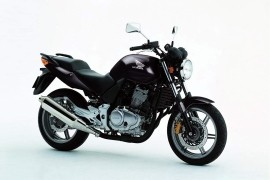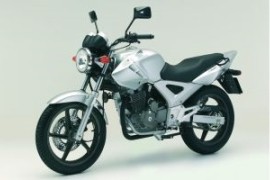HONDA CBF Models/Series Timeline, Specifications & Photos
First production year: 2003
In 2014, the Japanese motorcycle manufacturer released the Honda CBF125 Stunner, a reliable and efficient motorcycle best suited for commuting and short distances, with an agile and lightweight design that made it easy to handle, while its fuel efficiency and low-maintenance cost made it an affordable option for daily use.
The bike was first released in 2008 by Honda's Indian subsidiary HMSI and was available in two versions, such as the Stunner with a carburated engine and the Stunner PGM-FI that featured a fuel-injected engine.
The 2014 model didn't feature any significant changes and came with standard features, such as a blacked-out exhaust system, six-spoke cast aluminum wheels, a dual seat with a passenger grab handle, a wide handlebar, a black-finished frame, and a center stand.
For suspension, the bike packed a telescopic fork on the front and a three-way spring preload adjustable shock absorber on the rear, while the braking performance was achieved by a 240 mm disc with a two-piston caliper on the front wheel and a 130 mm drum unit on the rear wheel.
In the horsepower department, the 2014 Honda CB125 Stunner took its muscles from a 124cc four-stroke single-cylinder air-cooled engine that delivered an output power of 11 hp at 8,000 rpm and 11 Nm (8 lb-ft) of torque at 6,500 rpm.
All the power generated by the engine was sent to the rear wheel by a five-speed manual transmission that pushed the bike to a top speed of 99 kph (62 mph).
The Honda CBF125 Stunner was a lightweight, small-capacity half-naked machine manufactured by Honda's subsidiary HMSI in 2008. The bike was first sold in December 2008 and replaced the CG125 model, which has been in production for more than 30 years.
The bike was known as the Stunner in the Indian market and was available in two versions, such as the Stunner that featured a carburated engine and the Stunner PGM-FI that packed a fuel-injection system. In the European, Chinese, Singaporean, and Malaysian markets, the CBF125 was available only in the fuel-injected version.
In 2013, the Japanese motorcycle manufacturer launched the CBF125 Stunner, a half-naked motorcycle with the fairing mounted to the frame, which over its production years didn't feature any significant changes.
The 2013 machine came equipped with standard features, such as a blacked-out exhaust system, six-spoke cast aluminum wheels, a dual seat with a passenger grab handle, a wide handlebar, a black-finished frame, and a center stand.
In the power department, the 2013 Honda CBF125 Stunner had at its core a 124cc four-stroke single-cylinder air-cooled engine that delivered an output power of 11 hp with maximum strength at 8,000 rpm and 11 Nm (8 lb-ft) of torque available at 6,500 rpm.
With a dry weight of 129 kg (284 lbs) and set in motion by a five-speed manual transmission, the CBF125 Stunner reached a top speed of 99 kph (62 mph).
The Honda CBF125 was a lightweight, small-capacity motorcycle manufactured by Honda's Indian subsidiary HMSI in 2008. The difference between the CBF 125 and the CB125 was that the CB used a fork-mounted fairing, while the CBF packed a frame-mounted fairing.
In the Indian market, the CBF125 was known as the Stunner and available in two versions, such as the carburated version, simply known as Stunner, and the fuel-injected version, known as the Stunner PGM-FI. Also, in the European, Chinese, Singaporean, and Malaysian markets, the bike was available only in the fuel-injected version.
In 2012, the Japanese motorcycle manufacturer launched the Honda CBF125 Stunner, a standard motorcycle that didn't receive any changes during its production period and featured the same specifications as the previous models.
In addition, the bike packed standard features, such as cast aluminum wheels, a half-fairing with a small windscreen, a dual seat with a passenger grab handle, a wide handlebar, a blacked-out exhaust system, a black steel frame, and a center stand.
For suspension, the bike packed a telescopic fork on the front and a three-way spring preload adjustable shock absorber on the rear, while the braking performance was achieved by a 240 mm disc with a two-piston caliper on the front wheel and a 130 mm drum unit on the rear wheel.
As for the power figures, the 2012 Honda CBF125 Stunner has at its core a 124cc four-stroke single-cylinder air-cooled engine that delivered an output power of 11 hp at 8,000 rpm and 11 Nm (8 lb-ft) of torque at 6,500 rpm.
The Honda CBF1000 was a sport-touring motorcycle part of the CBF series in Honda's range manufactured from 2006 to 2018, powered by an engine based on the CBR1000RR Fireblade.
Also, the frame of the CBF1000 machine was based on the one used by the CBF600 model. The CBF1000 was manufactured by Honda Italia S.P.A and was first available in March 2006, mainly for the European market.
In 2010, the bike received a major revision that included a new design under the CBF1000F name with a new aluminum frame that replaced the steel unit used until that point, a four-into-one exhaust system, a new digital instrument panel, and a redesigned fairing and screen.
In 2012, the Japanese motorcycle manufacturer launched the Honda CBF1000FA, a big-bore machine with daily commuting and touring capabilities but also with sporty performance topped by excellent handling.
For suspension, the bike packed a 41 mm adjustable telescopic fork on the front and an HMAS gas-charged adjustable shock absorber on the rear for optimum suspension performance and handling.
In the braking department, the CBF1000 featured two 296 mm floating discs with two-piston calipers on the front wheel and a 240 mm disc squeezed by a single-piston caliper on the rear wheel.
As for power, the 2012 Honda CBF1000FA had its heartbeat set by a 998cc four-stroke four-cylinder liquid-cooled engine that delivered an output power of 106 hp at 9,000 rpm and 97 Nm (72 lb-ft) of torque at 6,500 rpm.
The 2011 Honda CBF600S was a sport-touring motorcycle part of the CBF family and, in its second generation, manufactured from 2008 to 2013. Compared to the CBF600N naked machine, the S model featured a different front fairing with a small windscreen and a dual headlight system.
Unlike the first generation, powered by a Honda Hornet-derived engine, the 2011 CBF600S took its muscles from a detuned version of the engine used on the 2007 Honda CBR600RR with an additional fuel injection system.
The new fuel-injected engine improved efficiency from five-seven liters to four-five liters per 100 km without messing with the output power. Also, the fuel tank was one liter larger than the previous one, offering slightly more range.
Another improvement for the 2011 machine was the new cast aluminum chassis that housed a new metallic grey painted engine instead of the black one previously used. As for colors, Honda introduced in 2010 new Black with Red, White with Red, and White with Blue color schemes.
As for suspension, the bike packed the same system as its predecessors, with a 41 mm conventional fork that handled the front end, while the rear was taken care of by a seven-way spring preload-adjustable shock absorber.
In the braking department, the 2011 Honda CBF600S featured six-spoke cast aluminum wheels fitted with two 296 mm discs with dual-piston calipers on the front and one 240 mm disc engaged by a single-piston caliper on the rear.
In 2004, the Japanese maker released the Honda CBF600N, a naked middleweight machine manufactured until 2007 as the first generation. The CBF family comprised the nude model and the half-faired CBF600S version with a front fairing and headlamp block.
Both models were powered by a 599cc four-cylinder Honda Hornet-based engine and featured an inspiring look that appealed to returning riders, new riders, and women. The engine and transmission were optimized for smooth power delivery.
The second generation was manufactured from 2008 to 2013 and powered by a completely new detuned CBR600RR engine fitted with a Programmed Fuel Injection (PGM-FI) system, providing smooth power, precise throttle response, and improved fuel efficiency.
The 2011 Honda CBF600N came in the same package as the previous model without any changes and is available in Pearl Cool White, Dragon Green Metallic, and Pearl Nightstar Black color schemes.
The braking performance was unchanged and still featured two 296 mm discs with two-piston calipers as front stopping power, paired with a single-piston caliper and a 240 mm disc, taking care of the rear wheel braking performance.
Also, the suspension didn't feature any changes and packed the same 41 mm telescopic fork on the front end and the same seve-way preload-adjustable shock absorber on the rear, offering excellent handling capabilities.
As for power, the 2011 Honda CBF600N, with its 599cc liquid-cooled four-cylinder fuel-injected engine, delivered an output power of 76 hp at 10,500 rpm and 58 Nm (44 lb-ft) of torque at 8,000 rpm.
The Honda CBF125 was a small-capacity, lightweight motorcycle manufactured in 2008 for road riders. The bike was known as the Stunner in the Indian market and was available in two versions, such as the carbureted one called Stunner and the fuel-injected version called Stunner PGM-FI.
In 2011, the Japanese motorcycle manufacturer launched the Honda CBF125 Stunner, a motorcycle that featured the same technical specifications as the previous model. In the European, Chinese, Singaporean, and Malaysian markets, the bike was available only in the fuel-injected version.
In addition, the 2011 Honda CBF125 Stuner was fitted with standard features, such as six-spoke cast aluminum wheels, a half-fairing with a small windscreen, a dual seat with a passenger grab handle, a wide handlebar, a black-finished exhaust system, a blacked-out steel frame, and a center stand.
For suspension, the bike packed a telescopic fork on the front and a three-way spring preload adjustable shock absorber on the rear, while the braking performance was achieved by a 240 mm disc with a two-piston caliper on the front wheel and a 130 mm drum unit on the rear wheel.
In the power department, the 2011 Honda CBF125 Stunner had its muscles from a 124cc four-stroke single-cylinder air-cooled engine that delivered an output power of 11 hp at 8,000 rpm and 11 Nm (8 lb-ft) of torque at 6,500 rpm.
In 2011, the Japanese motorcycle manufacturer launched the Honda CBF1000, a sport-touring motorcycle that debuted in 2006 and was built through 2018. The bike was developed as a sporty performer with a compact style and improved ergonomics, but also with Combined ABS as an option and panniers as standard.
When was first released in 2006, the bike packed a 998cc four-cylinder engine based on the CBR1000RR Fireblade and a steel frame based on the one used by the CBF600 model.
The 2011 machine featured the same modifications as its predecessor, with a new aluminum frame with lightweight, easy-to-handle, and agile capabilities topped by a single muffler that enhanced its sporty looks. Also, the sculpted half-fairing was designed to offer a large degree of wind protection at high speed but also excellent maneuverability.
For suspension, the bike packed a 41 mm adjustable telescopic fork on the front and an HMAS gas-charged adjustable shock absorber on the rear for optimum suspension performance and handling.
In the braking department, the CBF1000 featured two 296 mm floating discs with two-piston calipers on the front wheel and a 240 mm disc squeezed by a single-piston caliper on the rear wheel.
As for the performance figures, the 2011 Honda CBF1000 had at its core a 998cc four-stroke four-cylinder liquid-cooled engine that delivered an output power of 106 hp at 9,000 rpm and 97 Nm (72 lb-ft) of torque at 6,500 rpm.
The Honda CBF1000 was a sport-touring motorcycle part of the CBF series manufactured by Honda from 2006 to 2018. The bike was fitted with an engine based on the one used on the CBR1000RR Fireblade, installed in a frame based on the CBF600 model.
In 2010, the Japanese motorcycle manufacturer launched the Honda CBF1000, a machine developed as a sporty performer with a compact style and improved ergonomics. The bike came with Combined ABS as an option but was also available in a version with panniers as standard.
The 2010 CBF1000 came wrapped in a new aluminum frame with lightweight, easy-to-handle, and agile capabilities topped by a single muffler that enhanced its sporty looks. Also, the sculpted half-fairing was designed to offer a large degree of wind protection at high speed but also excellent maneuverability.
As for the colors, the bike was available in four different paint jobs that included Pearl Nightstar Black, Quasar Silver Metallic, Pearl Cool White, and Pearl Amber Yellow. All versions were available with black engines, engine covers, and wheels under a new CBF1000 logo.
In the power department, the 2010 Honda CBF1000 had its soul brought to life by a 998cc four-stroke four-cylinder liquid-cooled engine that delivered an output power of 106 hp at 9,000 rpm and 97 Nm (72 lb-ft) of torque at 6,500 rpm.
The Honda CBF1000 was a sport-touring motorcycle part of the CBF series manufactured by Honda from 2006 to 2018. The bike was fitted with an engine based on the one used on the CBR1000RR Fireblade, installed in a frame based on the CBF600 model.
In 2010, the Japanese motorcycle manufacturer launched the Honda CBF1000, a machine developed as a sporty performer with a compact style and improved ergonomics. The bike came with Combined ABS as an option but was also available in a version with panniers as standard.
The 2010 CBF1000 came wrapped in a new aluminum frame with lightweight, easy-to-handle, and agile capabilities topped by a single muffler that enhanced its sporty looks. Also, the sculpted half-fairing was designed to offer a large degree of wind protection at high speed but also excellent maneuverability.
As for the colors, the bike was available in four different paint jobs that included Pearl Nightstar Black, Quasar Silver Metallic, Pearl Cool White, and Pearl Amber Yellow. All versions were available with black engines, engine covers, and wheels under a new CBF1000 logo.
In the power department, the 2010 Honda CBF1000 had its soul brought to life by a 998cc four-stroke four-cylinder liquid-cooled engine that delivered an output power of 106 hp at 9,000 rpm and 97 Nm (72 lb-ft) of torque at 6,500 rpm.
It all started in 2004 when Honda introduced a new family of motorcycles part of the CBF series to replace the CB500 middleweight machine, no longer compliant with European emission standards.
The CBF600 family comprised two models, the CBF600N naked motorcycle and the CBF600S half-faired machine that packed an additional front fairing and dual headlights instead of the single unit featured by the naked one.
The first generation of the CBF600 models was manufactured beetwen 2004 to 2007, powered by a Honda Hornet-based engine and featuring a safety-inspired style that appealed to returning, new, and women riders.
The second generation of the CBF600 was manufactured from 2008 to 2013 and was an almost new concept that only carried the appearance of the first models. Also, the new models were compliant with the new EURO3 emission standards.
For power, the bikes packed a 2007 CBR600RR detuned engine fitted with a fuel injection system that improved fuel efficiency without changing the output power. The figures remained the same, with 76 hp on tap at 10,500 rpm and 58 Nm (43 lb-ft) of torque at 8,000 rpm.
In 2010, the Japanese maker released the Honbda CBF600S, a middleweight half-faired machine with sport-touring capabilities that offered smooth performance and comfortability. The bike didn't feature any significant changes over its production years and remained faithful to Honda's recipe right from its debut.
Also, in the braking and suspension departments, the 2010 Honda CBF600S sport-touring machine packed the same braking and suspension systems as its predecessors.
The Honda CBF600N was a naked motorcycle of the CBF family, manufactured from 2004 until 2013. Over its production run, the bike comprised the first generation from 2004 to 2007 and the second from 2008 to 2013.
In 2008, the CBF600N model came with an almost new package for the second generation and only shared its appearance with early models. Compared to the first model that featured a Hornet-based engine, the 2008 machine packed a detuned version of the engine used on the 2007 CBR600RR motorcycle.
Also, the new engine was fitted with a Programmed Fuel Injection (PGM-FI) system, improving fuel efficiency and delivering smooth power and precise throttle control without changing the maximum power output.
The new cast aluminum frame was designed to maintain optimal rigidity. It housed a lightweight 599cc four-cylinder engine while offering a classic naked design with timeless elegance and a comfortable ride with its three-position height-adjustable seat.
A two-piston caliper with two 296 mm discs took care of the front braking performance, and the rear was handled by a single-piston caliper with a 240 mm disc, offering strong stopping power.
As for suspension, a 41 mm telescopic fork handled the front suspension, and a seven-way preload-adjustable shock absorber took care of the rear, providing optimum suspension and handling performance.
The 2010 Honda CBF600N, with its 599cc four-cylinder liquid-cooled engine, boasted 76 hp with a peak at 10,500 rpm and 58 Nm (44 lb-ft) torque at 8,000 rpm.
In 2010, the Japanese motorcycle manufacturer launched the Honda CBF125 Stunner, a standard motorcycle that didn't receive any changes whatsoever and came with the same specifications as the previous model.
The CBF125 Stunner was available in the Indian market in two versions, such as the carburated version, simply known as Stunner, and the fuel-injected version, known as the Stunner PGM-FI. Also, in the European, Chinese, Singaporean, and Malaysian markets the bike was available only in the fuel-injected version.
The Honda CBF125 Stunner first went on sale in early December 2008 in the UK market and replaced the CG124 machine that has been in production for more than 30 years.
Also, the 2010 Stunner came equipped from the factory with standard features, such as six-spoke cast aluminum wheels, a half-fairing with a small windscreen, a dual seat with a passenger grab handle, a wide handlebar, a black-finished exhaust system, a blacked-out steel frame, and a center stand.
For suspension, the bike packed a telescopic fork on the front and a three-way spring preload adjustable shock absorber on the rear, while the braking performance was achieved by a 240 mm disc with a two-piston caliper on the front wheel and a 130 mm drum unit on the rear wheel.
As for the power figures, the 2010 Honda CBF125 Stunner took its muscles from a 124cc four-stroke single-cylinder air-cooled engine that delivered an output power of 11 hp at 8,000 rpm and 11 Nm (8 lb-ft) of torque at 6,500 rpm.
The family Honda CBF600 was born in 2004, when Honda introduced two motorcycles, the CBF600N naked and the CBF600S half-faired model, as a replacement for the Honda CB500, no longer compliant with the European emission regulations.
The difference between the two motorcycles was that the CBF600S half-faired one was fitted with an additional front cowl with a small windscreen for better wind protection and a dual headlight system instead of the single unit on the naked machine.
The bikes were manufactured over two generations, with the first generation built from 2004 to 2007 and the second from 2008 to 2013. The second generation was an almost entirely new design with a new engine and chassis.
In 2012, alongside the standard CBF600S model, the Japanese maker also released another version that packed an additional Anti-Lock Braking System (ABS). In addition to the ABS, the bike was fitted with a center stand available only for the CBF600S ABS motorcycles.
The 2010 Honda CBF600S ABS packed the same suspension settings as its predecessors, with a 41 mm telescopic fork handling the front end. The rear end was run by a seven-way spring preload-adjustable shock absorber.
The braking system was also carried from the previous models, with two 296 mm discs and a two-piston caliper taking care of the front stopping power and a 240 mm disc with a single-piston caliper handling the rear end.
As for power, the half-faired machine was fitted with a 599cc four-stroke liquid-cooled engine fed by an electronic fuel injection system and delivering 76 hp with a peak at 10,500 rpm and 58 Nm (43 lb-ft) torque at 8,000 rpm.
In 2009, Honda launched the CBF600S, a sport-touring machine part of the second generation of the CBF600 family, manufactured from 2008 until 2013. It was powered by a detuned version of the 2007 CBR600RR engine fitted with a fuel injection system.
The new fuel-injected engine improved fuel efficiency without changing the power output. The bike delivered the same output power as the first generation models, such as 76 hp at 10,500 rpm and 58 Nm (43 lb-ft) of torque at 8,000 rpm.
In addition, the second generation Honda CBF600S model packed a new cast aluminum chassis instead of the steel one used on the first generation. Also, the fuel tank capacity was increased by one liter, and the engine was painted metallic silver instead of the previously used black.
The color scheme was kept for the 2008 and 2009 models until 2010 when Honda introduced Black with Red, White with Red, and White with Blue liveries just for the faired version.
In the suspension department, the 2009 Honda CBF600S packed the same suspension as its predecessor, with a 41 mm fork on the front and a seven-position spring preload adjustable shock absorber on the rear.
Also, the stopping power was retained from previous models, with the same two 296 mm discs bolted to the six-spoke cast aluminum wheel on the front and engaged by dual-piston calipers. The rear end was handled by a 240 mm disc and a single-piston caliper.
In its first generation, the Honda CBF600N middleweight naked machine was manufactured from 2004 to 2007 and powered by a 599cc four-cylinder new design engine based on the Honda Hornet.
The second generation was manufactured from 2008 to 2013 with a detuned version of the engine used on the 2007 CBR600RR model, fitted with a fuel injection system and compliant with EURO3 emission standards.
The new engine came with improved fuel efficiency from five-seven to four-five liters per 100 km, keeping the same power output. Also, the fuel tank was enhanced by one liter, the engine was painted metallic gray instead of black, and the chassis was made of cast aluminum.
In the appearance department, the CBF600N and its CBF600S sister packed almost the same look as the first model released in 2004, but almost everything was new. The bike adopted a more relaxed riding position with the new backbone-cast aluminum frame.
The CBF600N was fitted with six-spoke lightweight cast aluminum wheels, featuring two 296 mm discs with two-piston calipers on the front and one 240 mm disc with a single-piston caliper on the rear that acted as stopping power.
For suspension, the 2008 Honda CBF600N featured a 41 mm telescopic fork on the front and a seven-way preload-adjustable shock absorber on the rear, offering optimum suspension performance and handling.
As for power, the 599cc four-cylinder liquid-cooled engine was fitted with a fuel injection system, providing smooth and precise power deliveri and an output power of 76 hp at 10,500 rpm and 58 Nm (44 lb-ft) of torque at 8,000 rpm.
The Honda CBF125 was a lightweight, small-capacity motorcycle manufactured by Honda's Indian subsidiary HMSI in 2008. The difference between the CBF 125 and the CB125 was that the CB used a fork-mounted fairing, while the CBF packed a frame-mounted fairing.
The CBF125 was also known as the Stunner in the Indian market and available in two versions, such as the carburated version, simply known as Stunner, and the fuel-injected version, known as the Stunner PGM-FI. Also, in the European, Chinese, Singaporean, and Malaysian markets, the bike was available only in the fuel-injected version.
The Honda CBF125 Stunner went on sale in early December 2008 in the UK market and replaced the CG124 machine that has been in production for more than 30 years.
In addition, the 2009 machine came equipped from the factory with standard features, such as six-spoke cast aluminum wheels, a half-fairing with a small windscreen, a dual seat with a passenger grab handle, a wide handlebar, a black-finished exhaust system, a blacked-out steel frame, and a center stand.
For suspension, the bike packed a telescopic fork on the front and a three-way spring preload adjustable shock absorber on the rear, while the braking performance was achieved by a 240 mm disc with a two-piston caliper on the front wheel and a 130 mm drum unit on the rear wheel.
In the power department, the 2009 Honda CBF125 Stunner had its soul brought to life by a 124cc four-stroke single-cylinder air-cooled engine that delivered an output power of 11 hp at 8,000 rpm and 11 Nm (8 lb-ft) of torque at 6,500 rpm.
In 2009, the Japanese motorcycle manufacturer launched the Honda CBF1000F, a sport touring motorcycle manufactured from 2006 to 2018, built around a steel frame based on the one used by the CBF600F model and set in motion by a 988cc four-cylinder engine based on the CBR1000RR unit.
The bike came with the same package as its predecessors, with no changes whatsoever. It packed a Programmed Fuel Injection (PGM-FI) system, an Anti-Lock Braking System (ABS) as an option, a combined half-fairing as standard, and an adjustable handlebar, seat, and windscreen.
It also packed standard features, such as a half-fairing with an adjustable windshield, a steel frame, a dual seat with passenger grab handles, a four-into-two exhaust system, and cast aluminum wheels.
For suspension, the bike featured a 41 mm adjustable telescopic fork on the front and an adjustable HMAS gas-charged shock absorber on the rear that provided optimum suspension performance and handling.
In the braking department, the bike packed two 296 mm floating discs with two-piston calipers on the front wheel and a 240 mm disc with a single-piston caliper on the rear wheel that offered strong stopping power.
In the power department, the 2009 Honda CBF1000F took its muscles from a 998cc four-stroke four-cylinder liquid-cooled engine that delivered an output power of 102 hp at 8,000 rpm and 97 Nm (72 lb-ft) of torque available at 6,500 rpm.
In 2009, the Japanese motorcycle manufacturer launched the Honda CBF1000F, a sport touring motorcycle manufactured from 2006 to 2018, built around a steel frame based on the one used by the CBF600F model and set in motion by a 988cc four-cylinder engine based on the CBR1000RR unit.
The bike came with the same package as its predecessors, with no changes whatsoever. It packed a Programmed Fuel Injection (PGM-FI) system, an Anti-Lock Braking System (ABS) as an option, a combined half-fairing as standard, and an adjustable handlebar, seat, and windscreen.
It also packed standard features, such as a half-fairing with an adjustable windshield, a steel frame, a dual seat with passenger grab handles, a four-into-two exhaust system, and cast aluminum wheels.
For suspension, the bike featured a 41 mm adjustable telescopic fork on the front and an adjustable HMAS gas-charged shock absorber on the rear that provided optimum suspension performance and handling.
In the braking department, the bike packed two 296 mm floating discs with two-piston calipers on the front wheel and a 240 mm disc with a single-piston caliper on the rear wheel that offered strong stopping power.
In the power department, the 2009 Honda CBF1000 took its muscles from a 998cc four-stroke four-cylinder liquid-cooled engine that delivered an output power of 102 hp at 8,000 rpm and 97 Nm (72 lb-ft) of torque available at 6,500 rpm.
In 2004, Honda released a family of two motorcycles, the CB600N naked machine, and the CB600S half-faired motorcycle. The bikes were manufactured from 2004 to 2007 as the first generation and were powered by a Honda Hornet-based engine.
In 2008, the Japanese maker launched the Honda CB600S, a sport-touring motorcycle and the first model part of the second generation that introduced a host of upgrades. The bike was compliant with EURO3 emission standards.
In the engine department, the bike was fitted with a new detuned version of the engine used on the 2007 CBR600RR. The engine featured a fuel injection system that improved fuel efficiency without changing the power output.
The 599cc four-cylinder liquid-cooled engine delivered an output power of 76 hp at 10,500 rpm and 58 Nm (43 lb-ft) of torque available at a throttle twist. Also, the fuel-injected engine provided smooth and precise power delivery.
Other improvements included a one-liter larger fuel tank, a new cast aluminum chassis, and the engine color changed from black to metallic grey. Also, the livery was kept for the 2008 and 2009 models, while in 2010, Honda introduced Black with Red, White with Red, and White with Blue color schemes.
The 2008 Honda CBF600S packed the same suspension system, with a 41 mm conventional telescopic fork on the front and a seven-position adjustable shock absorber on the rear.
Also, the braking system was carried over from the first generation, with two 296 mm discs mounted on the front wheel and engaged by dual-piston calipers, while the rear was handled by a single 240 mm disc with a single-piston caliper.
The Honda CBF1000 was a sport-touring motorcycle part of the CBF series in Honda's range manufactured from 2006 to 2018. The model was set in motion by a 998cc four-cylinder engine based on the CBR1000RR Fireblade powerplant.
Ishu Akari, the chief designer of the CBF1000, targeted riders over 30 years old who preferred smooth and progressive acceleration combined with a relaxed riding position and easy handling rather than top speed and high-revving power delivery like the CBR1000RR.
Compared to the CBR1000RR high-revving characteristic engine, the CBF1000 delivered more level power, which was best suited for inexperienced riders with its touring capabilities and higher power and torque in the low-mid rev range than the CBR1000RR.
The 2008 CBF1000 packed a Programmed Fuel Injection (PGM-FI) system, an Anti-Lock Braking System (ABS) as an option, a combined half-fairing as standard, and an adjustable handlebar, seat, and windscreen.
Also, the bike came equipped from the factory with standard features, such as a half-fairing with an adjustable windshield, a steel frame, a dual seat with passenger grab handles, a four-into-two exhaust system, and cast aluminum wheels.
In the power department, the 2008 Honda CBF1000 packed the same power specification as its predecessor, with its 998cc four-stroke four-cylinder liquid-cooled engine that delivered an output power of 102 hp at 8,000 rpm and 97 Nm (72 lb-ft) of torque available at 6,500 rpm.
The Honda CBF600 was a family of two motorcycles, the CB600N naked machine and the CB600S half-faired motorcycle manufactured from 2004 to 2007 as the first generation and powered by a Honda Hornet-based engine.
In 2008, the Japanese maker launched the Honda CB600S, a sport-touring motorcycle and the first model part of the second generation that introduced a host of upgrades. The bike was compliant with EURO3 emission standards.
In the engine department, the bike was fitted with a new detuned version of the engine used on the 2007 CBR600RR. The engine featured a fuel injection system that improved fuel efficiency without changing the power output.
The 599cc four-cylinder liquid-cooled engine delivered an output power of 76 hp at 10,500 rpm and 58 Nm (43 lb-ft) of torque available at a throttle twist. Also, the fuel-injected engine provided smooth and precise power delivery.
Other improvements included a one-liter larger fuel tank, a new cast aluminum chassis, and the engine color changed from black to metallic grey. Also, the livery was kept for the 2008 and 2009 models, while in 2010, Honda introduced Black with Red, White with Red, and White with Blue color schemes.
The 2008 Honda CBF600S packed the same suspension system, with a 41 mm conventional telescopic fork on the front and a seven-position adjustable shock absorber on the rear.
Also, the braking system was carried over from the first generation, with two 296 mm discs mounted on the front wheel and engaged by dual-piston calipers, while the rear was handled by a single 240 mm disc with a single-piston caliper.
The Honda CBF600 was a middleweight machine part of the CBF family that comprised the CBF600N naked bike and the CBF600S half-faired motorcycle. The CBF600N was manufactured from 2004 until 2007 in its first generation and was different than its CBF600S sister by the front fairing and headlamp block.
The second generation was manufactured from 2008 to 2013 under the PC43 code name and met the EURO3 emission standards with the 2008 model. The 2008 CBF600N machine was powered by a detuned version of the 2007 CBR600RR engine.
The new engine was fitted with electronic fuel injection, improving the fuel efficiency from five-seven liters to four-five liters per 100 km without changing the maximum power output.
Other improvements with the new 2008 machine included a one-liter larger fuel tank, a new cast aluminum frame, and a new metallic gray color for the engine instead of the black previously used.
The color scheme was retained for the 2008 and 2009 models, while in 2010, Black with Red, White with Red, and White with Blue were added for the CB600S half-faired version. The 2008 Honda CBF600N was available in Pearl Nightstar Black, Pearl Sienna Red, and Quasar Silver Metallic.
In the performance department, the 2008 Honda CBF600N delivered an output power of 76 hp with a peak at 10,500 rpm with 58 Nm (44 lb-ft) torque at 8,000 rpm from its CBR600RR-derived 599cc four-cylinder liquid-cooled engine.
The six-speed manual transmission took power generated by the engine, sending it to the ground and rushing the bike to a top speed of 200 kph (125 mph).
In 2008, the Japanese motorcycle manufacturer released the Honda CBF250, a standard machine in Honda's range and an entry-level model with a small displacement engine, primarily designed for city commuting and beginner riders.
The Honda CBF250 was manufactured from 2004 until 2015, and over its production years, it didn't feature any significant upgrades, except for graphics and color changes, remaining similar to the previous models.
Also, the bike provided a comfortable and ergonomic seating position with its low seat height, which made it easy for riders of all sizes to maintain control and reach the ground while offering comfortable riding over long distances.
In addition, the 2008 CBF250 packed standard features, such as a one-piece dual seat with passenger grab handles, a wide handlebar, an analog instrument cluster, a black-finished exhaust system with a chromed muffler, a round headlight, a steel frame, and cast aluminum wheels with a five-spoke design.
The suspension was handled by a 37 mm telescopic fork on the front and a single shock absorber on the rear, and the stopping power was achieved by a 276 mm disc squeezed by a two-piston caliper on the front wheel and one 130 mm drum braking unit on the rear.
For power, the 2008 Honda CBF250 took its muscles from a 249cc four-stroke four-cylinder air-cooled engine that delivered an output power of 24 hp with maximum strength at 8,000 rpm and 22 Nm (16 lb-ft) of torque available at 6,000 rpm.
In 2007, the Japanese motorcycle manufacturer launched the Honda CBF1000, a sport-touring motorcycle manufactured from 2006 to 2018, powered by a 998cc four-cylinder engine based on the CBR1000RR Fireblade powerplant.
The Honda CBF1000 was part of the CBF series and featured a steel frame based on the one used by the CBF600 model. The CBF1000 was manufactured by Honda Italia S.p.A and was first available in March 2006, mainly for the European market.
The bike came with the same package as its predecessor, with no changes whatsoever. It packed a Programmed Fuel Injection (PGM-FI) system, an Anti-Lock Braking System (ABS) as an option, a combined half-fairing as standard, and an adjustable handlebar, seat, and windscreen.
As standard features, the bike packed a half-fairing with an adjustable windshield, a steel frame, a dual seat with passenger grab handles, a four-into-two exhaust system, and cast aluminum wheels.
For suspension, the bike featured a 41 mm adjustable telescopic fork on the front and an adjustable HMAS gas-charged shock absorber on the rear that provided optimum suspension performance and handling.
In the braking department, the bike packed two 296 mm floating discs with two-piston calipers on the front wheel and a 240 mm disc with a single-piston caliper on the rear wheel that offered strong stopping power.
As for the power figures, the 2007 Honda CBF1000 had its soul brought to life by a 998cc four-stroke four-cylinder liquid-cooled engine that delivered an output power of 102 hp at 8,000 rpm and 97 Nm (72 lb-ft) of torque available at 6,500 rpm.
In 2007, the Japanese manufacturer launched the Honda CBF600S, a sport-touring motorcycle in its last production year of the first generation that packed the same appearance and technical specifications as the previous models.
The CBF600S half-faired model was first released in 2004, along with the CBF600N naked machine, and came as a replacement for the Honda CB500 that didn't compile with the new European emission standards.
Both models featured a safety-inspiring appearance that appealed to returning, new and women riders. At the same time, its power was taken from a 599cc Honda Hornet-based engine fed by four VP-type carburetors.
Like the previous models, the Honda CBF600S provided a decent range with its 20-liter fuel tank but also offered a comfortable riding position, making it suitable for long-distance ridings.
The bike featured a three-position adjustable seat and a two-position adjustable windscreen, making it perfect for riders of all sizes. In addition, the gearbox and engine were optimized for smooth power delivery.
Under the hood, the 2007 Honda CBF600S packed a 599cc four-cylinder liquid-cooled powerplant with an output power of 76 hp at 10,500 rpm and 58 Nm (43 lb-ft) torque at 8,000 rpm.
Attached to the engine was a six-speed manual transmission that converted the power generated by the engine and sent it to the rear wheel through a chain drive, launching the bike to a top speed of 202 kph (126 mph).
The 2007 Honda CBF600N was a naked bike part of the CBF series in Honda's range and the last model manufactured for the first generation. The bike was identical to the previous models and didn't bring any changes.
When it was first released in 2004, along with its half-faired CBF600S sister, the CBF600 replaced the CB500 machine, no longer compliant with European emission standards.
The difference between the naked and half-faired machines consisted just in the front fairing and headlamp block, while both model's engine and gearbox were optimized to offer smooth power delivery.
Some of the standard features fitted on the bike comprised the black steel frame, black-finished cast aluminum wheels, a dual seat with passenger grab handles, a round headlight, and a center stand only on the optional ABS model.
From the factory, the CBF600N was equipped with six-spoke cast aluminum wheels fitted with two 296 mm discs and three-piston calipers on the front and a 240 mm with a single-piston caliper on the rear for strong stopping power.
As for suspension, the model packed a 41 mm telescopic fork on the front coupled to a shock absorber with seven-position spring preload adjustability on the rear, offering optimum handling performance.
The 76 hp at 10,500 rpm and 58 Nm ( 44 lb-ft) torque at 8,000 rpm resulted from the reliable and fuel-efficient 599cc four-cylinder liquid-cooled engine and pushed the 2007 Honda CBF600N to a claimed top speed of 200 kph (125 mph).
The Honda CBF250 was a standard motorcycle part of the CBF series in the Honda range of motorcycles, also known as the CBX250 Twister, which replaced the CBX200 Strada that ended production in 2002.
In 2007, the Japanese motorcycle manufacturer launched the Honda CBF250, a versatile and reliable machine that came in a lightweight design with responsive handling and great fuel efficiency, which resulted in a popular choice for riders who were looking for an easy-to-maintain and affordable machine.
In addition, the 2007 model came equipped from the factory with standard features, such as a one-piece dual seat with passenger grab handles, a wide handlebar, an analog instrument cluster, a black-finished exhaust system with a chromed muffler, a round headlight, a steel frame, and cast aluminum wheels with a five-spoke design.
For handling, the steel frame housed a 37 mm telescopic fork on the front and a single shock absorber on the rear for optimum suspension performance, while the stopping power was generated by a 276 mm disc squeezed by a two-piston caliper on the front wheel and one 130 mm drum braking unit on the rear wheel for optimum braking performance.
As for the power figures, the 2007 Honda CBF250 had its soul brought to life by a 249cc four-stroke four-cylinder air-cooled engine that delivered an output power of 24 hp with maximum strength at 8,000 rpm and 22 Nm (16 lb-ft) of torque available at 6,000 rpm.
The honda CBF1000 had its debut in 2006 as a sport touring motorcycle part of the CBF series in Honda's range of motorcycles, set in motion by a 998cc four-cylinder engine based on the CBR1000RR Fireblade and carried a steel frame based on the CB600F.
Ishu Akari, the chief designer of the CBF1000, targeted riders over 30 years old, who preferred smooth and progressive acceleration combined with a relaxed riding position and easy handling rather than top speed.
Also, the bike featured a Programmed Fuel Injection (PGM-FI) system, an Anti-Lock Braking System (ABS) as an option, a combined half-fairing as standard, and an adjustable handlebar, seat, and windscreen.
In 2010, the Japanese motorcycle manufacturer launched a new version of the CBF1000 that featured a new design but also a GT version that packed a full lower fairing, panniers, and a top box.
The major changes of the 2010 CBF1000 included a new aluminum frame instead of the steel one used until that point, a four-into-one exhaust system that replaced the previous four-into-two unit, a new digital instrument cluster, and a redesigned fairing and windscreen.
As for the power figures, the 2010 Honda CBF1000 delivered more power from the 998cc four-stroke four-cylinder liquid-cooled engine, such as 106 hp with maximum strength at 9,000 rpm and 97 Nm (72 lb-ft) of torque at 6,500 rpm, while the overall weight and fuel consumption were lowered.
The Honda CBF1000 was a sport-touring motorcycle part of the CBF series in Honda's range manufactured from 2006 to 2018. The model was set in motion by a 998cc four-cylinder engine based on the CBR1000RR Fireblade powerplant.
Also, the frame of the CBF1000 machine was based on the one used by the CBF600 model. The CBF1000 was manufactured by Honda Italia S.p.A and was first available in March 2006, mainly for the European market.
Ishu Akari, the chief designer of the CBF1000, targeted riders over 30 years old who preferred smooth and progressive acceleration combined with a relaxed riding position and easy handling.
Compared to the CBR1000RR high-revving characteristic engine, the CBF1000 delivered more level power, which was best suited for inexperienced riders with its touring capabilities and higher power and torque in the low-mid rev range than the CBR1000RR.
Also, the bike featured a Programmed Fuel Injection (PGM-FI) system, an Anti-Lock Braking System (ABS) as an option, a combined half-fairing as standard, and an adjustable handlebar, seat, and windscreen.
In the performance department, the 2006 Honda CBF1000 took its thrust from a 998cc four-stroke four-cylinder liquid-cooled engine that delivered an output power of 102 hp at 8,000 rpm and 97 Nm (72 lb-ft) of torque available at 6,500 rpm.
The CBF600S was first released in 2004 as a sport-touring machine that replaced the Honda CB500, which was no longer compliant with European emission standards. The bike was powered by a Hornet-based engine and featured a safe and inspiring appearance.
In the CBF family were two models, the CBF600N naked machine and the CBF600S half-faired bike that packed an additional front fairing with a small windshield for better wind protection and dual headlights instead of a single unit on the naked model.
Both models met EURO2 emission standards, while Anti-Lock Braking System (ABS) was optional. The model that featured the optional ABS braking system also came with a center stand.
In 2006, the maker launched the Honda CBF600S, a sport-touring machine in its third year of production. It didn't bring any changes and featured the exact technical and visual specifications as the previous models.
A 41 mm telescopic fork handled the front suspension, while the stopping power was achieved by two 296 mm discs mounted on the six-spoke cast aluminum wheels, engaged by two dual-piston calipers.
On the rear end, the CBF600S packed a seven-way spring preload-adjustable shock absorber, taking care of the rear suspension, while a single-piston caliper with a 240 mm disc handled the braking power.
As for power, the 2006 Honda CBF600S delivered an output power of 76 hp at 10,500 rpm and 58 Nm (43 lb-ft) of torque at 8,000 rpm from a Hornet-based 599cc four-stroke liquid-cooled in-line four engine.
In its first generation and third year of production, the Honda CBF600N made its way into the market with no additional changes and the exact specification of the previous models.
The 2006 machine featured a comfortable riding position with a relatively low seat height, making it easy for less experienced riders to handle. The bike was also known for its reliability and versatility and was an excellent choice for commuting, touring, and even light off-road adventure.
The bike was born in 2004 and replaced the CB500 machine no longer compliant with European emission standards. The new design of the CBF was based on the existing Hornet engine, topped by an inspiring look.
The front six-spoke cast aluminum wheel was fitted with two 296 mm discs and three-piston calipers that acted as stopping power, and for suspension, it packed a 41 mm telescopic fork.
The rear wheel featured a 240 mm disc engaged by a single-piston caliper for strong braking performance and a mono-shock damper with seven-position spring preload adjustability handled by the rear suspension.
With 76 hp on the clock, the 2006 Honda CBF600N's 599cc four-cylinder liquid-cooled engine also delivered 58 Nm (44 lb-ft) of brute torque. The power went through a six-speed manual transmission and a chain drive, which spun the rear wheel to a top speed of 200 kph (125 mph).
In 2006, the Japanese motorcycle manufacturer launched the Honda CBF500, a standard motorcycle best suited as a commuter and beginner machine, with decent performance, being well-built, reliable, and excellent handling capabilities.
The Honda CBF500 was a standard motorcycle part of the CBF series, manufactured from 2004 to 2007 and as a EURO2-compliant replacement for the Honda CB500. The bike was powered by a 499cc parallel-twin engine that developed 56 hp and a top speed of 201 kph (125 mph).
Like the earlier CB models, the CBF500 packed the same engine, transmission, and final drive, with the engine used as a stressed member of the chassis. It also featured updated fuel and emissions systems, a new instrument cluster, new bodywork, and new suspension.
In addition, the CBF500 was packed with standard features that included a round headlight, a dual seat with passenger grab handles, cast aluminum wheels, a black-finished steel frame, a wide handlebar, one analog and one digital instrument panel, and a side stand.
In the horsepower department, the 2006 Honda CBF500 took its muscles from a 499 cc four-stroke parallel-twin liquid-cooled engine that delivered an output power of 56 hp at 9,500 rpm and 45 Nm (33 lb-ft) of torque at 8,000 rpm.
Overall, the Honda CBF500 was a well-equipped machine like the average mid-sized commuter that packed a good quality braking system, suspension, and comfortable seat.
The Honda CBF250 was a standard motorcycle part of the CBF series in Honda's range of motorcycles and an entry-level machine best suited for commuting and beginner riders. The bike was manufactured from 2004 until 2015 and didn't carry any significant changes except for graphics and color options.
In 2006, the Japanese motorcycle manufacturer launched the Honda CBF250, which came in a compact, sleek, and lightweight package which offered a touch of urban class with an easy thrill of performance.
Also, the 2006 machine came wrapped in standard features, such as a round headlight with a chromed ring, a one-piece dual seat with passenger grab handles, a blacked-out exhaust system with a chromed muffler, twin instrument panels, and cast aluminum wheels.
For stability, the bike featured a tubular steel frame that carried a telescopic fork on the front and a single shock absorber on the rear that provided optimum suspension performance.
As for braking performance, the bike packed a single 276 mm disc squeezed by a two-piston caliper on the front wheel and a 180 mm drum unit on the rear wheel.
In the power department, the 2006 Honda CBF250 had its soul brought to life by a 249cc four-stroke single-cylinder air/oil-cooled engine fed by a carburetor and delivered an output power of 24 hp with maximum strength at 8,000 rpm and 24 Nm (18 lb-ft) of torque available at 6,000 rpm.
In 2004, along with the CBF600N naked model, the Japanese motorcycle maker launched the Honda CBF600S, a half-faired motorcycle manufacturer until 2007 that packed an additional front fairing and a different headlight block.
The CBF600 family replaced the CB500 series, which was no longer compliant with European emission standards, and introduced a new design based on the existing Hornet engine with a safety-inspiring look.
The 2004 CBF600S was in the first generation, featuring a half-fairing with a small windscreen, a steel frame, a dual seat with passenger grab handles, an analog and digital instrument cluster, dual headlights, and lightweight six-spoke cast aluminum wheels.
For suspension, the 2004 CBF600S machine featured a 41 mm conventional telescopic fork on the front and a seven-position preload adjustable shock absorber on the rear for optimum suspension and handling.
As for braking performance, the bike packed the same system as its sister, with two 296 mm discs squeezed by a couple of dual-piston calipers on the front and a single-piston caliper with a 240 mm disc on the rear.
The 2004 Honda CBF600S was a reliable and capable machine with good performance with its 599cc four-cylinder liquid-cooled engine delivered an output power of 76 hp at 10,500 rpm and 58 Nm (43 lb-ft) torque at 8,000 rpm.
The power generated by the engine, combined with a 218 kg (480 lbs) dry weight and a six-speed manual transmission, resulted in a top speed of 202 kph (126 mph).
The naked middleweight CBF600N was a motorcycle in Honda's range manufactured from 2004 to 2007, which comprised the first generation that also included a half-faired model named the CBF600S with an additional front fairing and headlamp block.
When Honda released the CBF600N machine in 2004, it replaced the older CB500 model no longer compliant with European emission standards. The 600F was based on the existing Hornet with an appearance that inspired safety for less experienced riders.
Both CBF600N and its sister CBF600S met EURO2 emission standards at the time of their release, and ABS came as an option on both models. Two interesting features were the three-position adjustable seat and the two-position adjustable windscreen.
The manufacturer fitted the bike with standard features, including black-finished cast aluminum wheels, a dual seat with passenger grab rails, a black steel frame, a round headlight, and an analog and digital instrument panel.
On the front end, a 41 mm telescopic fork took care of the front suspension, and the mono-shock damper with seven-way spring-preload adjustability handled the bike's rear suspension.
The six-spoke aluminum wheels were fitted with two 296 mm discs and three-piston calipers on the front and, while on the rear, it packed the 240 mm disc with a single-piston caliper that acted as braking performance.
The 2005 Honda CBF600N featured a steel frame wrapped around a 599cc liquid-cooled four-cylinder engine with 76 hp on the clock at 10,500 rpm and 58 Nm (44 lb-ft) torque with a peak at 8,000 rpm.
The Honda CBF500 was a standard motorcycle part of the CBF series, manufactured from 2004 to 2007 and as a EURO2-compliant replacement for the Honda CB500. The bike was powered by a 499cc parallel-twin engine that developed 56 hp and a top speed of 201 kph (125 mph).
Like the earlier CB models, the CBF500 packed the same engine, transmission, and final drive, with the engine used as a stressed member of the chassis. It also featured updated fuel and emissions systems, a new instrument cluster, new bodywork, and new suspension.
Unlike the CB models, the CBF was only available as a naked machine without the half-fairing of the previous CB500S, while two versions of the CBF were produced, a non-ABS one and an ABS version that went under the CBF500A name.
The bike came equipped from the factory with standard fittings such as a round headlight, a dual seat with passenger grab handles, cast aluminum wheels, a black-finished steel frame, a wide handlebar, one analog and one digital instrument panel, and a side stand.
After 2007, the Honda CBF500 was discontinued due to EURO3 standard regulations that become mandatory in the EU at the time and was replaced by the larger 600cc four-cylinder Honda CBF600.
As for the power figures, the 2004 to 2007 Honda CBF500 had its soul brought to life by a 499 cc four-stroke parallel-twin liquid-cooled engine that delivered an output power of 56 hp at 9,500 rpm and 45 Nm (33 lb-ft) of torque at 8,000 rpm.
In 2005, the Japanese motorcycle manufacturer launched the Honda CBF250, an entry-level machine with a small displacement engine designed primarily for city commuting and beginner riders.
The bike was manufactured from 2004 to 2015, and over the years, it didn't feature any significant updates except for graphic and color changes remaining similar to earlier models. Overall, the CBF250 was a reliable and affordable machine with a compact size, fuel efficiency, and comfortable riding that made it a popular choice among beginner and experienced riders.
In addition, the bike came equipped from the factory with standard features, such as a round headlight with a chromed ring, a one-piece dual seat with passenger grab handles, a blacked-out exhaust system with a chromed muffler, twin instrument panels, and cast aluminum wheels.
The CBF250 was built around a tubular steel frame that housed a telescopic fork on the front and a single shock absorber on the rear for optimum suspension performance, while the stopping power was achieved by a single 276 mm disc squeezed by a two-piston caliper on the front wheel and a 180 mm drum unit on the rear wheel.
In the performance department, the 2005 Honda CB250 had at its core a 249cc four-stroke single-cylinder air/oil-cooled engine fed by a carburetor and delivered an output power of 24 hp with maximum strength at 8,000 rpm and 24 Nm (18 lb-ft) of torque available at 6,000 rpm.
In 2005, the Japanese motorcycle manufacturer launched the Honda CBF500, a naked machine manufactured from 2004 to 2007, powered by a 499cc parallel-twin engine that developed 56 hp and a top speed of 201 kph (125 mph).
After 2007, the Honda CBF500 was discontinued due to EURO3 standard regulations that become mandatory in the EU at the time and was replaced by the larger 600cc four-cylinder Honda CBF600.
Like the earlier CB model, the CBF500 packed the same engine, transmission, and final drive, with the engine used as a stressed member of the chassis. It also featured updated fuel and emissions systems, a new instrument cluster, new bodywork, and new suspension.
Unlike the CB models, the CBF was only available as a naked machine without the half-fairing of the previous CB500S, while two versions of the CBF were produced, a non-ABS one and an ABS version that went under the CBF500A name.
In addition, the 2005 CBF500 came equipped with standard features that included a round headlight with a chromed ring, a dual seat with passenger grab handles, cast aluminum wheels, a black-finished steel frame, a wide handlebar, an analog and digital instrument cluster, and a side stand.
As for the power figures, the 2005 Honda CBF500 had its heartbeat set by a 499 cc four-stroke parallel-twin liquid-cooled engine that delivered an output power of 56 hp at 9,500 rpm and 45 Nm (33 lb-ft) of torque at 8,000 rpm.
The Honda CBF250 was a half-faired motorcycle manufactured from 2004 until 2015, also known as the CBX250 Twister in South America, Argentina, Mexico, and South Africa. The bike replaced the CBX200 Strada, which ended its production in 2002.
Over its production years until 2015, the Honda CBF250 carried minor updates, such as graphics and color changes, remaining similar to earlier models. Overall, the CBF250 was a reliable and affordable machine with a compact size, fuel efficiency, and comfortable riding that made it a popular choice among beginner and experienced riders.
The bike came equipped from the factory with standard features, such as a round headlight with a chromed ring, a one-piece dual seat with passenger grab handles, a blacked-out exhaust system with a chromed muffler, twin instrument panels, and cast aluminum wheels.
For suspension, the bike packed a telescopic fork on the front and a single shock absorber on the rear for optimum suspension performance, while the stopping power was generated by a single 276 mm disc squeezed by a two-piston caliper on the front wheel and a 180 mm drum unit on the rear.
In the power department, the Honda CBF250 had its heartbeat set by a 249cc four-stroke single-cylinder air/oil-cooled engine fed by a carburetor and delivered an output power of 24 hp with maximum strength at 8,000 rpm and 24 Nm (18 lb-ft) of torque available at 6,000 rpm.
In 2004, when the Japanese maker released the Honda CBF600N naked middleweight machine, it also made available a half-faired version called CBF600S that packed an additional front fairing and headlight block.
The CBF600S model was powered by a 599cc four-cylinder Honda Hornet-based engine with a new design. The engine, along with the gearbox, was optimized for smooth power delivery.
The 2004 CBF600S met EURO2 emissions standards and featured an appearance that inspired safety, appealing to returning, new and women riders. Both CBF600N naked and CBF600S half-faired machines were available with Anti-Lock Braking System (ABS) as an option.
In the braking department, the Honda CBF600S packed the same system as its naked sister, with two dual-piston calipers and 296 mm discs on the front wheel, while the rear wheel was taken care of a 240 mm disc engaged by a single-piston caliper.
Also, the suspension was shared with the naked model and packed a 41 mm conventional telescopic fork handling the front end. The rear end was held by a seven-way preload-adjustable shock absorber.
The 599cc Hornet-derived engine boasted 76 hp at 10,500 rpm and 58 Nm (44 lb-ft) of torque at 8,000 rpm. With a six-speed manual transmission converting the power from the engine, the 2004 Honda CBF600S machine reached a top speed of 202 kph (126 mph).
The Honda CBF600 was a middleweight machine manufactured by the Japanese maker from 2004 until 2007 as the first generation. In the CBF600 family were only two motorcycles, such as the CBF600N, the naked one, and the CBF600S, the half-faired one.
Due to not complying with the European emission standards at the time, the CB500 middleweight machine was replaced by the new CBF model, which featured a new design based on the existing Hornet engine and gave it a look that inspired returning riders, new riders, and women.
The EURO2 emission standards were met by the new model, while the Anti-Lock Braking System (ABS) was optional on both naked and half-faired machines. However, the ABS model came with a center stand as standard.
Some of the highlights featured by the models were the seat, which was three-position adjustable, and the windscreen, which also featured two-position adjustability. For the faired version, the maker offered four color schemes: Black, Dolphin Grey, Pearl Red, and Metallic Blue.
The bike rolled from the manufacturing plant on a set of six-spoke cast aluminum wheels, fitted on the front with two 296 mm discs and three-piston calipers and one 240 mm disc with a single-piston caliper on the rear for strong stopping power.
The engine and gearbox were optimized for smooth power delivery, and the 2004 Honda CBF600N boasted 76 hp at 10,500 rpm and 58 Nm (44 lb-ft) torque at 8,000 rpm from the 599cc four-cylinder liquid-cooled and fuel-injected engine.
The Honda CBF500 was a standard motorcycle part of the CBF series, manufactured from 2004 to 2007 and as a EURO2-compliant replacement for the Honda CB500. The bike was powered by a 499cc parallel-twin engine that developed 56 hp and a top speed of 201 kph (125 mph).
Also, the Honda CBF500 was discontinued after 2007 due to EURO3 standard regulations that become mandatory in the EU and was replaced by the larger four-cylinder 600cc Honda CBF600.
Like the earlier CB model, the CBF500 packed the same engine, transmission, and final drive, with the engine used as a stressed member of the chassis. It also featured updated fuel and emissions systems, a new instrument cluster, new bodywork, and new suspension.
Unlike the CB models, the CBF was only available as a naked machine without the half-fairing of the previous CB500S, while two versions of the CBF were produced, a non-ABS one and an ABS version that went under the CBF500A name.
For suspension, the bike packed a 41 mm telescopic fork on the front with 120 mm of wheel travel and a seven-way preload adjustable shock absorber on the rear with 125 mm of wheel travel.
As for stopping power, the bike featured two 296 mm discs with two-piston calipers on the front wheel and a 240 mm disc with a single-piston caliper on the rear wheel for optimum braking performance.
In the power department, the 2004 Honda CBF500 had its soul brought to life by a 499 cc four-stroke parallel-twin liquid-cooled engine that delivered an output power of 56 hp at 9,500 rpm and 45 Nm (33 lb-ft) of torque at 8,000 rpm.
In 2004, the Japanese motorcycle manufacturer launched the Honda CBF250, a standard motorcycle part of the CBF series of Honda machines that came in a compact, sleek, and lightweight package with a touch of urban class and an easy thrill of performance.
The Honda CBF250 was a small entry-level machine manufactured by Honda from 2004 to 2015, also known as the CBX250 Twister in South America, Argentine, Mexico, and South Africa.
Over its production years until 2015, the Honda CBF250 carried minor updates, such as graphics and color changes, remaining similar to earlier models. Overall, the CBF250 was a reliable and affordable machine with a compact size, fuel efficiency, and comfortable riding that made it a popular choice among beginner and experienced riders.
The CBF250 packed standard features, such as a round headlight with a chromed ring, a one-piece dual seat with passenger grab handles, a blacked-out exhaust system with a chromed muffler, twin instrument panels, and cast aluminum wheels.
For suspension, the bike packed a telescopic fork on the front and a single shock absorber on the rear for optimum suspension performance, while the stopping power was generated by a single 276 mm disc squeezed by a two-piston caliper on the front wheel and a 180 mm drum unit on the rear.
As for power, the 2004 Honda CBF250 took its muscles from a 249cc four-stroke single-cylinder air/oil-cooled engine fed by a carburetor and delivered an output power of 24 hp with maximum strength at 8,000 rpm and 24 Nm (18 lb-ft) of torque available at 6,000 rpm.
